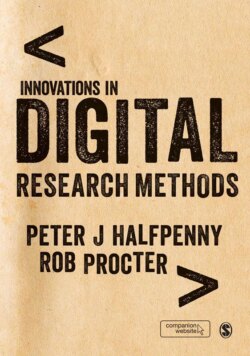Читать книгу Innovations in Digital Research Methods - Группа авторов - Страница 54
На сайте Литреса книга снята с продажи.
2.4.1 Researcher/Subject Boundaries
ОглавлениеThere is a tradition within social science research of involving respondents in the research process and breaking down boundaries between researcher and subject. This tradition has been described as action research and participant research (Bryman, 2013; Emerson et al., 1995; McCall and Simmons, 1969). Here, research is done with participants rather than on them. Moreover, the research might be led or co-led by a particular interest group, such as service users or organization members.
Extending this, several authors have argued that we are in a time where conventional social science boundaries are being blurred. Elliot (2011) posits that, as the proportion of our lives spent online grows, so the boundary between data and subject becomes less distinct. In the same sense that a person’s real life identity is partially constructed in the memories of others as they interact with him or her, so the person’s online self is partially constructed in the data footprints that they leave, intentionally or unintentionally. The activities of others also contribute to constructing these footprints, for example, a photograph of a person might be in the public domain as a result of being posted online by someone else. The photograph might contain identification information and meta-identity information. Given the apparent socio-technical trends, one need not go as far as the Singulatarians (e.g. Kurzweil, 2005) to acknowledge that this transfer of identity is likely to intensify.
Along similar lines, Martin (2012) predicts that the distinction between data and analysis will become less clear. Undoubtedly, as we move from datasets to data streams and data arrays, analytical processes will be less divisible from the data that are analysed. Extending this idea, Perceptual Control Theory (see, for example, Marken, 2010) and its analogues suggest that the data collection-analysis-policy impact workflow could eventually become a closed loop system, even to the extent of policy makers having a ‘hands-on’ role in its management. So, rather than researchers analysing data and then the results feeding through into policy impact in a lagged and somewhat ad hoc manner, we might envisage researchers-cum-policy analysts directly intervening in social processes using real time data systems as a tool and combining what, in the past, might have been seen as very different data types and different stages of the conventional social research process.
On a more immediate and less speculative note, we observe that as more ‘found’ data are used in research, the distinction between primary and secondary data itself becomes less consequential. But the use and legal status of any data for social science research needs to be clearly understood by both citizens and researchers alike. There are major data literacy and training issues here that need to be addressed (Elliot et al., 2013). This includes how the new types of data and information may be affecting more traditional data types. For example, how are the ways in which people’s attitudes are formulated and expressed changing under the influence of social media?
